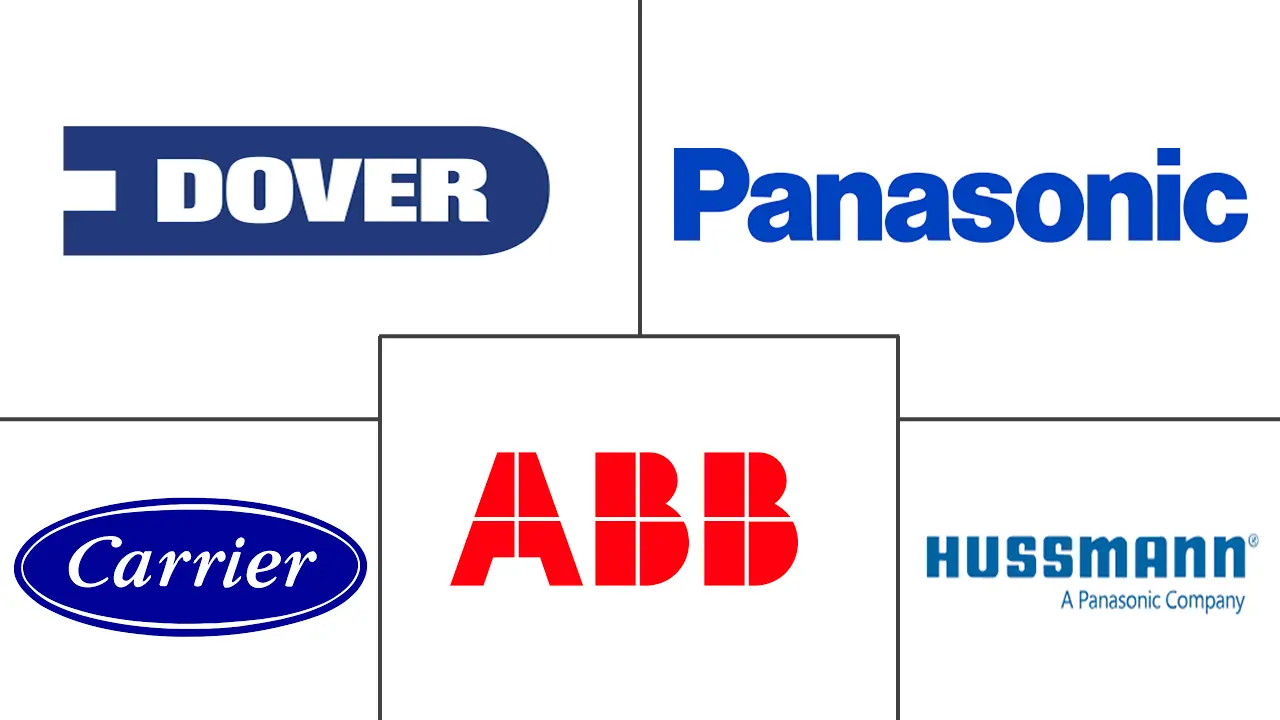Commercial Refrigeration Equipment Market Size and Share

Commercial Refrigeration Equipment Market Analysis by Mordor Intelligence
The commercial refrigeration equipment market size is valued at USD 44.9 billion in 2025 and is forecast to reach USD 60.1 billion by 2030, advancing at a 6.0% CAGR. Regulatory pressure from energy-efficiency mandates, rapid adoption of natural refrigerants, and rising e-commerce cold-chain requirements underpin this expansion. Plug-in systems gain favor for their modularity, while transcritical CO₂ designs earn share in large food retail formats. Manufacturers accelerate R&D to comply with the U.S. Department of Energy (DOE) standards effective 2029, a shift expected to cut 19.7 million t of CO₂ emissions and save consumers USD 4.6 billion over 30 years.[1]Department of Energy, “Energy Conservation Standards for Commercial Refrigerators, Freezers, and Refrigerator-Freezers,” Federal Register, federalregister.gov Consolidation follows suit, exemplified by Haier’s USD 775 million purchase of Carrier’s commercial refrigeration arm in 2024, which reconfigured the competitive order and intensified investment in natural-refrigerant portfolios.
Key Report Takeaways
- By product type, refrigerated display cases led with 49.6% revenue share in 2024, while transportation refrigeration is projected to expand at a 7.8% CAGR through 2030.
- By refrigerant type, fluorocarbons held 62.0% of the commercial refrigeration equipment market share in 2024, whereas hydrocarbons are forecast to grow at an 8.5% CAGR to 2030.
- By application, supermarkets and hypermarkets accounted for 34.3% of the commercial refrigeration equipment market size in 2024, while e-commerce dark stores advance at a 9.4% CAGR.
- By system configuration, plug-in units captured 46.0% market share in 2024 and are increasing at a 7.1% CAGR.
- By geography, North America dominated with 35.6% share in 2024; Asia-Pacific is the fastest-growing region at a 7.3% CAGR.
Global Commercial Refrigeration Equipment Market Trends and Insights
Drivers Impact Analysis
| Driver | (~) % Impact on CAGR Forecast | Geographic Relevance | Impact Timeline |
|---|---|---|---|
| Expansion of organized food retail | +1.2% | Global | Medium term (2-4 years) |
| Energy-efficiency regulations & incentives | +0.8% | North America & EU | Short term (≤ 2 years) |
| Shift toward natural refrigerants (HC/CO₂) | +0.7% | EU, NA, APAC | Long term (≥ 4 years) |
| IoT-enabled predictive maintenance adoption | +0.5% | Global | Medium term (2-4 years) |
| Source: Mordor Intelligence | |||
Expansion of Organized Food Retail
Supermarkets, hypermarkets, and cash-and-carry formats are scaling floor space, demanding multi-temperature zones and energy-efficient display lines. In India, organized retail penetration advanced from 12% to 15% between 2020 and 2024, catalyzing procurement of high-capacity chillers, walk-in coolers, and smart cabinets. Retailers seek integrated refrigeration controls to optimize merchandising layouts and shrink energy bills, prompting vendors to bundle hardware with cloud-based monitoring suites. Larger footprints spur demand for centralised rack systems that streamline servicing schedules. As emerging markets follow similar retail templates, the commercial refrigeration equipment market gains sustained volume growth.
Energy-Efficiency Regulations & Incentives
The DOE’s 2025 conservation rules compel a 15% jump in equipment efficiency by 2029, triggering replacement cycles across grocery, c-store, and hospitality segments. California’s attorney general, backed by eight other states, continues to push for swift adoption, citing USD 4.6 billion in lifetime consumer savings.[2]California Attorney General’s Office, “Attorney General Bonta Continues to Urge DOE to Cease Unlawful Delays on Energy Efficiency Standards for Commercial Refrigeration Equipment,” oag.ca.gov Similar policies in the EU extend eco-design and F-gas restrictions, expanding retrofits beyond the United States. Because energy costs represent up to 50% of grocery utility bills, end-users view payback periods below four years as acceptable, accelerating demand for ECM fan motors, high-efficiency doors, and variable-capacity compressors.
Shift Toward Natural Refrigerants (HC/CO₂)
Europe surpassed 90,000 stores using transcritical CO₂ by 2024, while propane cabinets topped 17 million units.[3]International Institute of Refrigeration, “Increase in the Use of Natural Refrigerants in Commercial Refrigeration,” iifiir.org Large European chains report return-on-investment parity versus legacy HFC systems, reinforcing adoption momentum. CO₂ installations now penetrate warmer climates due to parallel compression and ejector advances. Inorganics such as ammonia proliferate in larger distribution centers seeking ultra-low GWP profiles. Skill gaps endure, yet OEM-led training modules and remote-service analytics are closing those deficits, bolstering the commercial refrigeration equipment market.
IoT-Enabled Predictive Maintenance Adoption
Connected sensors track compressor cycling, door openings, and ambient loads, allowing neural algorithms to predict component failure before product loss occurs. Research indicates energy savings of 10-15% when IoT modules feed into building-management platforms. Retailers have begun coupling alert dashboards with service work-order apps, reducing truck rolls and unplanned downtime. Data-fusion obstacles persist, but cloud-agnostic APIs and edge computing alleviate bandwidth stress. Vendors that package analytics with hardware secure recurring software revenue and deepen customer lock-in.
Restraints Impact Analysis
| Restraint | (~) % Impact on CAGR Forecast | Geographic Relevance | Impact Timeline |
|---|---|---|---|
| High upfront & maintenance costs | -0.9% | Global | Short term (≤ 2 years) |
| Growing market for used/rental units | -0.4% | Developed markets | Medium term (2-4 years |
| Source: Mordor Intelligence | |||
High Upfront & Maintenance Costs
Natural-refrigerant cabinets and variable-speed compressors carry price premiums of 20-30%, placing them out of reach for small food retailers running thin margins. Payback periods average 3.5 years—beyond typical planning horizons—so operators defer upgrades even as energy prices rise. Service calls on CO₂ systems often require certified technicians, raising hourly rates. Government rebate schemes offset some capital burden, but coverage remains patchy. Financing partnerships and as-a-service models have emerged, yet they are not universally available.
Growing Market for Used/Rental Units
Refurbished display cases and leased walk-ins undercut new-equipment prices by 30-40%, lengthening asset replacement cycles. The secondary channel flourishes in North America and Western Europe where equipment pools are abundant. While rentals offer flexibility, they hinder adoption of low-GWP refrigerants and advanced controls critical to decarbonisation goals. OEMs respond by promoting trade-in rebates and subscription models tied to preventative maintenance, but leakage of service revenue to third-party refurbishers persists.
Segment Analysis
By Product Type: Transportation Refrigeration Drives Innovation
Refrigerated display cases still command 49.6% of 2024 revenue, sustained by supermarket roll-outs and DOE rules that encourage door-retrofit programs. Multipurpose merchandisers integrate LED lighting and high-performance glass to trim utility bills. Niche categories such as blast chillers and ice-cream freezers serve hospitality and QSR kitchens, providing steady volume. Walk-in cooler replacements will spike from 2025 as compliance deadlines loom, reinforcing growth prospects for remote rack suppliers and door component OEMs.
Transportation refrigeration is poised to expand at a 7.8% CAGR through 2030 as e-commerce platforms shorten delivery windows and governments curb diesel emissions. California’s ban on diesel transport refrigeration for medium-duty trucks accelerates electric unit retrofits. The commercial refrigeration equipment market size for mobile systems is set to increase as logistics operators pivot to battery-electric or engine-agnostic solutions equipped with telematics. Partnerships between Performance Food Group and Penske Truck Leasing highlight fleet-scale pilots that validate lower total cost of ownership.
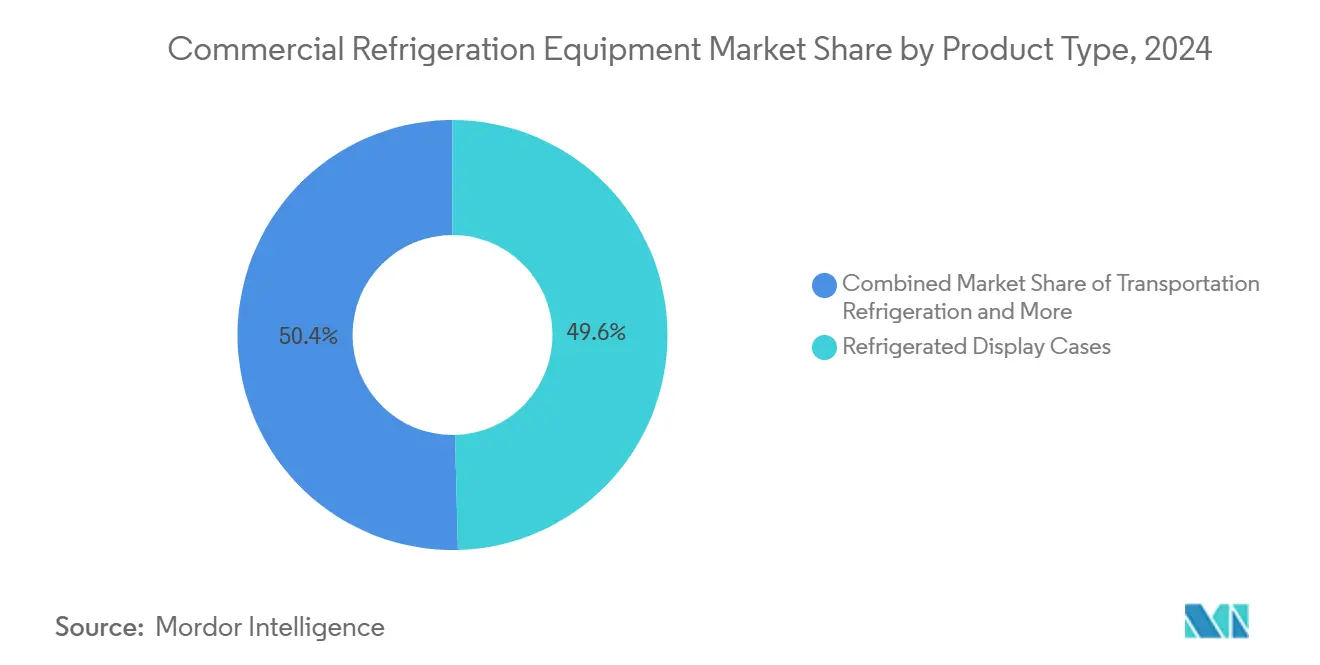
Note: Segment shares of all individual segments available upon report purchase
By Refrigerant Type: Natural Alternatives Gain Momentum
Fluorocarbons captured 62.0% market share in 2024, yet hydrocarbons are slated to rise at an 8.5% CAGR, backed by F-gas quota cuts and Kigali targets. Retailers in Europe report strong performance from propane cabinets, shifting procurement specifications accordingly. Ammonia and CO₂ solutions dominate large cold-store and hypermarket projects, benefiting from heat-recovery add-ons that drive energy paybacks below three years.
Synthetic lower-GWP blends such as R-454B serve as bridging options. Johnson Controls’ portfolio migration illustrates how OEMs hedge risk while service networks upskill for natural refrigerants. Component suppliers adjust gasket, lubricant, and valve designs to accommodate flammable safety classes, ensuring smooth scale-up of the commercial refrigeration equipment market.
By Application: E-commerce Dark Stores Reshape Demand
Supermarkets and hypermarkets accounted for 34.3% of the commercial refrigeration equipment market size in 2024, fueled by format modernization and food-safety codes. Yet dark stores and micro-fulfillment hubs will post a 9.4% CAGR, reflecting retailers’ preference for last-mile proximity. Forecasts point to 6,600 additional micro-fulfillment centers by 2030, each requiring compact, high-throughput chillers.
Healthcare, pharmaceuticals, and specialty chemicals adopt tighter temperature-control tolerances, expanding demand for premium cabinets with redundant compressors and continuous data logging. Hotels and restaurants invest in under-counter units and slide-in reach-ins that maximize back-of-house space, boosting the commercial refrigeration equipment market share for flexible footprints.
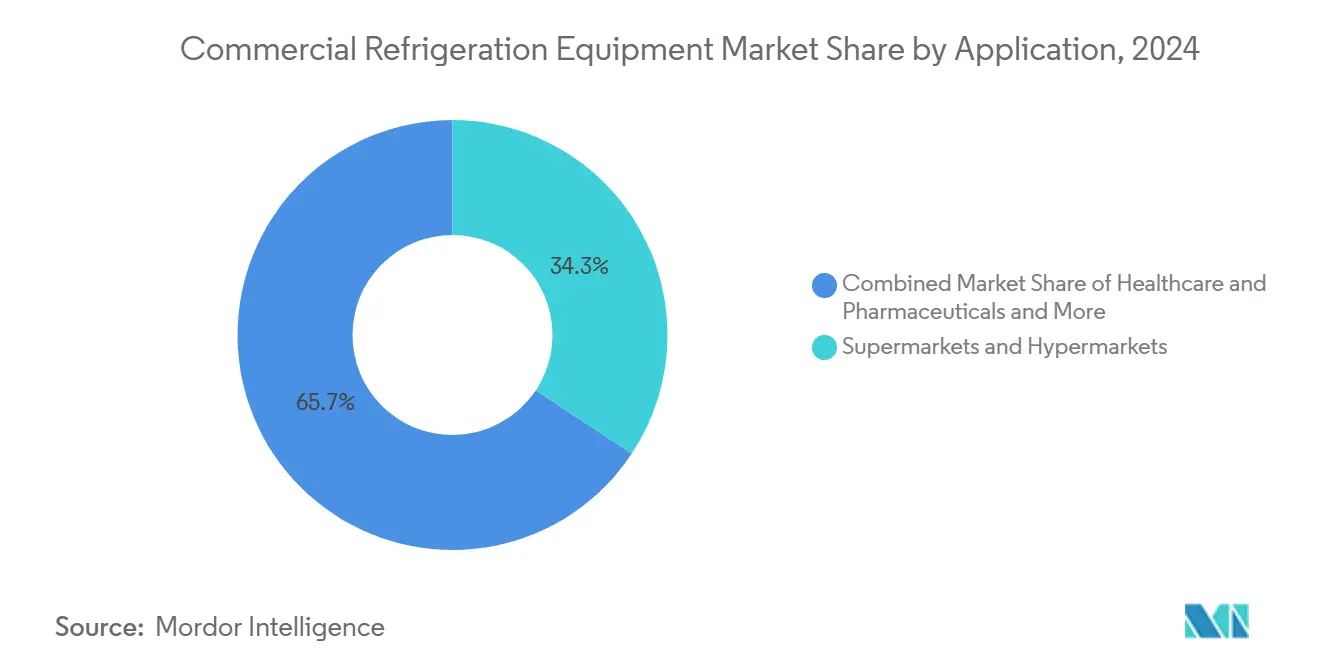
Note: Segment shares of all individual segments available upon report purchase
By System Configuration: Plug-in Units Dominate Flexibility
Plug-in cabinets held 46.0% share in 2024 and are climbing at a 7.1% CAGR as retailers favor units that install quickly and isolate failure points. Their self-contained architecture eases maintenance, a decisive benefit for convenience formats with limited back-room capacity. Remote condensing units and multiplex racks retain relevance in large hypermarkets and distribution hubs seeking centralized load balancing.
Imminent 2028 component efficiency thresholds for walk-ins drive early replacements and eco-power controllers that trim energy draw. IoT-ready plug-ins now ship with factory-installed gateways, facilitating predictive maintenance and warranty analytics that fortify OEM-customer relationships within the commercial refrigeration equipment market.
Geography Analysis
North America leads with 35.6% revenue share in 2024 due to early regulatory adoption, mature cold-chain infrastructure, and sizeable food-retail square footage. Supermarket chains adopt transcritical CO₂ across flagship stores to meet ESG goals while securing utility rebates. The region’s legislative cadence, including AIM Act HFC phase-downs, forecasts stable retrofit demand throughout the decade.
Asia-Pacific posts the highest regional CAGR at 7.3%. Rapid urbanisation and rising disposable income propel organised retail in India, where market value is on track to double to INR 10,000 crore (USD 1.2 billion) by FY28. China’s compressor manufacturing scale lowers cost curves globally, yet trade frictions may prompt regional sourcing shifts. Japan pioneers energy-efficient showcases and heat-recovery rack systems, with the national market predicted to reach USD 55,433.1 million by 2032.
Europe intensifies decarbonisation, with nearly 30% food-retail penetration of transcritical CO₂ by 2024. Programs such as RefNat4LIFE train small grocers in safe hydrocarbon handling, mitigating technician shortages. South America and Africa remain nascent but benefit from supermarket rollouts tied to urban middle-class expansion, unlocking new addressable volume for the commercial refrigeration equipment market.
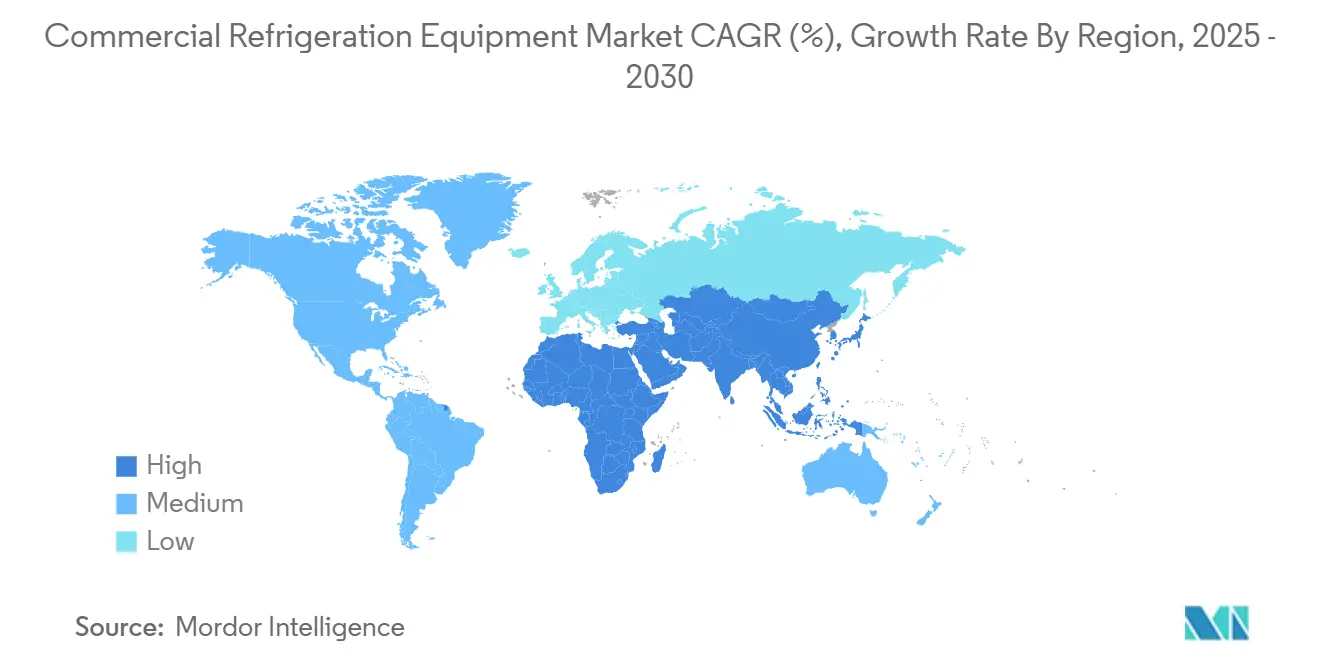
Competitive Landscape
Industry consolidation intensifies as global players seek scale and technology breadth. Haier’s USD 775 million acquisition of Carrier’s commercial refrigeration unit added premium CO₂ brands such as Green & Cool, enhancing its European footprint and granting access to a 4,000-strong workforce . The deal also secures OEM control over critical components amid supply-chain volatility.
Strategic focus shifts from price competition to differentiation via energy-efficiency, natural refrigerant expertise, and IoT ecosystems. OEMs embed cloud portals that transform equipment into data platforms, unlocking service-based revenue. Patent filings for low-GWP technologies climbed sharply between 2016 and 2019, spurred by evolving F-gas regulations. Mid-tier firms utilise mergers to acquire digital competencies; Husky Intelligent Fridges’ January 2025 purchase of Selfly Store strengthens its software stack for cashier-less vending .
Service models evolve as fleet electrification and natural refrigerant adoption demand specialised technician networks. Cold Core Group’s acquisition of Fore-Front Mechanical in 2024 exemplifies vertical integration, enabling cross-selling of industrial refrigeration builds with outsourced facilities management
Commercial Refrigeration Equipment Industry Leaders
-
Carrier Transicold (Carrier Global Corporation)
-
Dover Corp. (Hillphoenix & Anthony)
-
Danfoss A/S
-
Panasonic Corp.
-
Hussmann (Panasonic subsidiary)
- *Disclaimer: Major Players sorted in no particular order
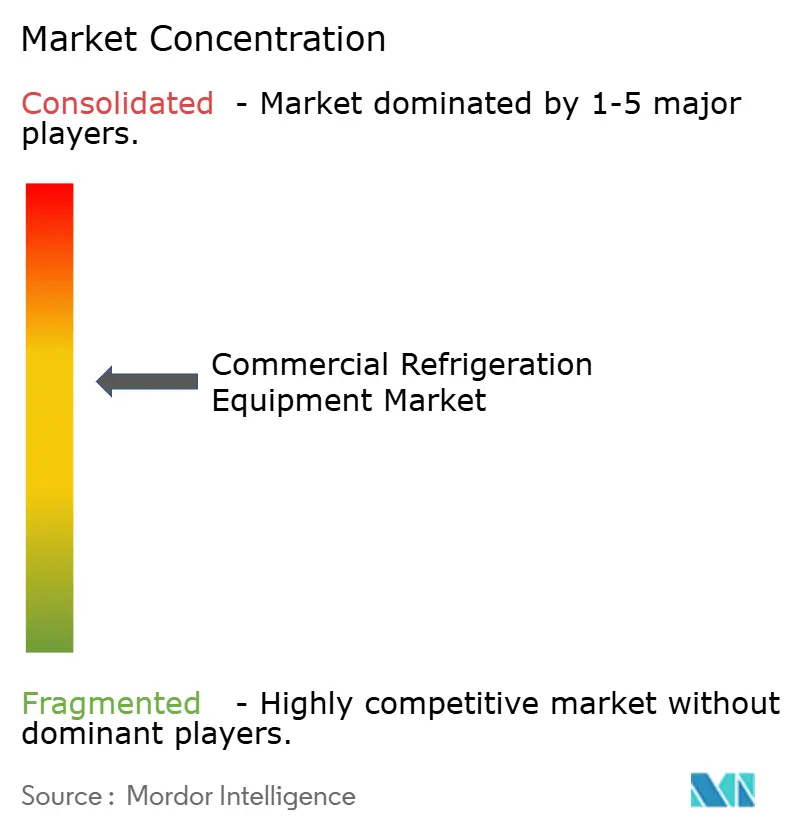
Recent Industry Developments
- January 2025: Husky Intelligent Fridges acquired Selfly Store to enhance its position in intelligent vending solutions, targeting the European unmanned retail market projected to reach EUR 3.1 billion (USD 3.4 billion) by 2031. The acquisition leverages Selfly Store's 52% increase in average revenue for operators in 2024, demonstrating strong market potential for smart vending technologies.
- January 2025: The U.S. Department of Energy finalized energy conservation standards for commercial refrigeration equipment, effective January 2029, requiring significant efficiency improvements and projected to save consumers USD 4.6 billion over 30 years while reducing CO₂ emissions by 19.7 million metric tons.
- October 2024: Haier Smart Home completed its USD 775 million acquisition of Carrier's commercial refrigeration business, adding over 4,000 employees and brands including Profroid, Celsior, and Green & Cool to enhance its global market position and CO₂ technology capabilities.
- October 2024: old Core Group acquired Fore-Front Mechanical to expand industrial refrigeration services capabilities, focusing on cross-selling opportunities and geographic expansion in the food industry where refrigeration needs are critical.
Research Methodology Framework and Report Scope
Market Definitions and Key Coverage
Our study defines the commercial refrigeration equipment market as global factory-gate revenue from new refrigerators, freezers, refrigerated display cases, beverage coolers, blast chillers, transportation refrigeration units, ice machines, vending machines, and walk-in cold rooms used across food retail, foodservice, healthcare, chemicals, and logistics settings. We consider only original equipment sold by manufacturers; installation charges appear where bundled with the unit price, ensuring consistency with Mordor's 2025 baseline of USD 44.90 billion.
Scope Exclusions: Refurbished or rental units, standalone spare-parts sales, and domestic-grade appliances are excluded.
Segmentation Overview
- By Product Type
- Blast Chillers
- Refrigerators & Freezers
- Transportation Refrigeration
- Refrigerated Display Cases
- Beverage Refrigeration
- Ice-cream Freezers
- Refrigerated Vending Machines
- Other Product Types
- By Refrigerant Type
- Fluorocarbons
- Hydrocarbons
- Inorganics (NH₃, CO₂)
- By Application
- Food and Beverage
- Food Service and Distribution
- Hotels and Restaurants
- Bakeries
- Other F&B Applications
- Retail
- Supermarkets and Hypermarkets
- Convenience Stores
- Other Retail Stores
- Chemicals
- Healthcare and Pharmaceuticals
- Other Applications
- Food and Beverage
- By System Configuration
- Plug-in / Self-contained Units
- Remote Condensing Units
- Multiplex Rack Systems
- Walk-in Coolers/Freezers
- By Geography
- North America
- United States
- Canada
- Mexico
- South America
- Brazil
- Argentina
- Chile
- Rest of South America
- Europe
- Germany
- United Kingdom
- France
- Italy
- Spain
- Rest of Europe
- APAC
- China
- India
- Japan
- South Korea
- Indonesia
- Australia
- New Zealand
- Rest of APAC
- Middle East and Africa
- GCC
- South Africa
- Nigeria
- Egypt
- Kenya
- Rest of Middle East and Africa
- North America
Detailed Research Methodology and Data Validation
Primary Research
Telephone and online interviews with manufacturers, compressor suppliers, food-retail facilities managers, and regional cold-chain integrators across North America, Europe, Asia-Pacific, and the Middle East test secondary findings, uncover average selling prices, and benchmark penetration of natural refrigerants. Responses also refine growth drivers such as dark-store roll-outs and quick-service restaurant expansions.
Desk Research
Mordor analysts begin with structured searches of tier-1 open sources such as UN Comtrade shipment data, the US Energy Information Administration appliance efficiency database, Eurostat PRODCOM output tables, and the Japan Refrigeration and Air Conditioning Industry Association shipment bulletins. Company 10-Ks, investor decks, and trade-association fact sheets (e.g., North American Association of Food Equipment Manufacturers) sharpen product splits, while paid repositories like D&B Hoovers and Dow Jones Factiva supply historical revenue trails and strategic moves. National regulations on refrigerant transitions published by the US EPA and the EU F-Gas Regulation guide technology uptake assumptions. This list is illustrative; many other sources are routinely screened to validate numbers and fill gaps.
Market-Sizing & Forecasting
A top-down model scales national production, import, and export figures to reconstruct apparent consumption, which is then cross-checked with sampled bottom-up roll-ups of leading supplier revenues and channel checks. Key variables like average selling price by cabinet type, new retail floor-space additions, food-service outlet counts, refrigerant phase-out timelines, and GDP-linked disposable-income shifts anchor the multivariate regression forecast. Where country-level customs codes pool commercial and household units, ratio splits obtained from primary interviews adjust the totals before the five-year ARIMA projection is run.
Data Validation & Update Cycle
Outputs pass a two-step analyst and research-manager review; variance triggers flag deviations over three percentage points versus historical trends, and clients receive refreshed datasets annually, with interim updates after material events such as policy changes on high-GWP gases.
Why Our Commercial Refrigeration Equipment Baseline Commands Dependability
Published figures vary because firms adopt different product baskets, pricing bases, and refresh cadences.
Key gap drivers include: some providers fold aftermarket service and rental revenue into equipment sales, others omit transportation refrigeration, and many still convert currencies at single-month spot rates, whereas Mordor applies average fiscal-year rates and a consistent exclusion policy.
Benchmark comparison
| Market Size | Anonymized source | Primary gap driver |
|---|---|---|
| USD 44.90 B (2025) | Mordor Intelligence | |
| USD 57.41 B (2025) | Global Consultancy A | Includes maintenance contracts and rental fleets, inflating base |
| USD 51.66 B (2025) | Trade Journal B | Uses distributor-level prices and bundles cold-room panels |
In sum, our disciplined scope, verified variables, and yearly refresh give decision-makers a balanced, transparent baseline they can retrace and replicate with confidence.
Key Questions Answered in the Report
What is the projected value of the commercial refrigeration equipment market by 2030?
The market is forecast to reach USD 60.1 billion by 2030 at a 6.0% CAGR.
Which product segment is growing fastest?
Transportation refrigeration is advancing at a 7.8% CAGR, underpinned by e-commerce logistics and diesel-phase-out mandates.
How are regulations influencing technology choices?
DOE efficiency standards effective 2029 and global F-gas quotas are steering buyers toward high-efficiency components and natural refrigerant systems.
Why are plug-in units gaining popularity?
Plug-in cabinets offer installation flexibility and lower service complexity, capturing 46.0% market share in 2024 with a 7.1% growth outlook.
Page last updated on:
